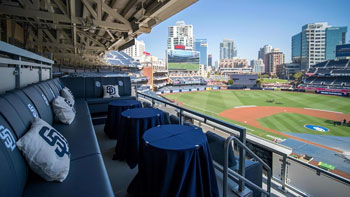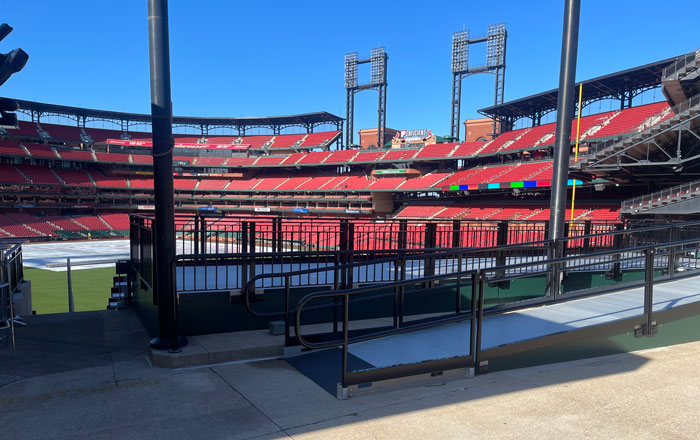The way we watch sports in person has been evolving at a rapid clip, with more sports venues of all varieties finding new ways to drive attendance and ticket sales by creating a more immersive fan experience.
“Going to ballgames has become less about rooting on your favorite team and more about the overall experience of the event,” said Mike Mendoza, director of business development for Sightline Commercial Solutions, a premier staging and railing solutions provider. “Fans have shown a want for social experiences that are driving changes in seating layouts to VIP spaces, loge boxes, standing areas with drink rails, open concourses and in-park bars and restaurants. Similarly, the younger generation has gravitated toward the VIP experience, which has driven additions of field-side suites and premium areas with spacious views, comfortable/plush seating and space to dine, drink and socialize.”
Working with the New York Mets at Citi Field, Sightline designed and installed a new fan zone just beyond the left field wall.
With its reduced fence height and shortened distance from home plate, this space gives fans an opportunity to socialize in a community setting. Aluminum platforms serve as the base of the party deck, and ADA platforms with continuous handrail and a slip-resistant surface ensure accessibility, while drink ledges add convenience.
At the San Diego Padres’ Petco Park, the team installed a VIP Platform infill section, which features larger tiers for a more spacious, premium viewing experience. Custom guardrails made of anodized aluminum with acrylic infill were specially engineered to support TV screens and deliver a high-end, aesthetically appealing look. Add cushy seating, cupholders and tables with cloth coverings, and the entire fan experience has been transformed into a unique and engaging day at the ballpark.

“The social spaces at both Citi Field and Petco Park not only generate livelier and more energetic atmospheres on gamedays, but also afford fans the opportunity to embrace the action in a more communal setting,” said Regional Sales Manager Ray Byrnes. “Rather than cramming into standard seats high above the field, they can experience our national pastime in an environment that prioritizes fan comfort and exceptional views.”
Traditionally, ballparks tend to have fixed seating areas—rows of fold-up seats on concrete stadia, Mendoza added. A “portable platform system can transform fixed seating areas into loge boxes, VIP spaces and flexible seating,” he said. “This transformation of seats provides fans with an improved ‘experience’ while providing opportunities for facilities to increase revenue and draw fans in.
“In addition to platform overlays, the addition of drink rail to concourse and standing areas has expanded the viewing and socializing areas of many ballparks. These areas are oftentimes underutilized so the addition of a drink rail provides a purpose to the space.”
What’s more, adding a drink rail creates these more sociable viewing areas without breaking the bank. The cost-conscious price point of such projects makes them appealing to ballparks at every level, including collegiate and minor league facilities, Mendoza said.
At Southwest University Park, home to the El Paso Chihuahuas, the Triple-A affiliate of the San Diego Padres, aluminum drink rail is among the 10,000-plus linear feet of custom architectural railing. The drink rail is used throughout the interior and exterior of the ballpark, providing convenient support for concessions, beverages and belongings so fans can enjoy the game from any location in the stadium.
The park also boasts anodized aluminum picket, mesh and grip rail in the party deck, standing room and berm sections, along with a frameless glass railing system on the balcony overlook and staircase in the Club Suite area, and custom powder-coated steel fencing around the perimeter of the facility.
To get started on making your own ballpark a more immersive experience for fans, Mendoza suggests taking a look at rethinking underused spaces.
“We suggest reviewing underutilized spaces within the ballpark and asking how ‘dead areas’ can be used to generate additional revenue and activity,” he explained. “What is your typical attendance? Are there areas with regularly vacant seats that can be transformed into VIP or loge-style seating spaces to generate more revenue (albeit at the expense of reduced seating capacity)? Solutions can be tailored to specific ballparks.”
At Busch Stadium in St. Louis, the solution involved improving accessibility. The team recently installed a wheelchair-accessible platform section with a slip-resistant ramp, safety guardrail and aluminum closure panels to create dedicated areas designed to cater to Cardinals fans with disabilities. The project not only improved access and sightlines for wheelchair users, but also opened surrounding areas to allow for better traffic flow. RM



